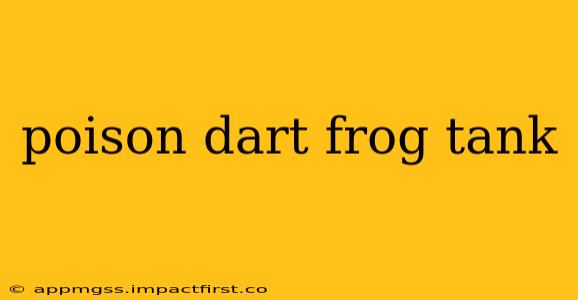Keeping poison dart frogs is a rewarding but challenging hobby. These stunning amphibians require a meticulously maintained environment to thrive. This guide will cover everything you need to know about setting up the perfect poison dart frog tank, from choosing the right enclosure to understanding their dietary needs. Remember, responsible ownership involves thorough research and a commitment to providing optimal care.
What size tank do I need for poison dart frogs?
The size of your tank depends largely on the species of poison dart frog and the number you plan to house. Generally, you'll need a minimum of a 10-gallon tank for a single frog, but larger is always better. For multiple frogs, aim for at least a 20-gallon long tank, and even larger for larger species or groups. A larger tank provides more space for natural behaviors, reduces stress, and makes maintenance easier. Remember to calculate space based on adult frog size, not juvenile size.
What kind of substrate is best for poison dart frogs?
The substrate is crucial for humidity control and overall frog health. A well-draining mix is essential to prevent bacterial growth and root rot. A popular choice is a blend of abiotic materials like coconut fiber, orchid bark, and leaf litter. This mix provides good drainage, retains moisture, and creates a natural-looking floor. Avoid using soil, as it can harbor harmful microorganisms. A layer of sphagnum moss on top helps retain moisture and provides a comfortable surface for the frogs.
How do I maintain the humidity in a poison dart frog tank?
Maintaining the correct humidity is paramount. Poison dart frogs require high humidity levels, typically between 70% and 90%. This can be achieved through several methods:
- Regular misting: Mist the tank several times a day using a spray bottle to replicate natural rainfall.
- Automatic misting system: Consider investing in an automatic misting system for consistent humidity control.
- Water features: A small waterfall or water dish adds humidity and provides a drinking source.
- Substrate choice: A well-draining substrate that retains moisture is essential.
Regularly monitor humidity levels using a hygrometer.
What kind of lighting do poison dart frogs need?
Poison dart frogs don't need bright, direct sunlight; in fact, it can be harmful. They thrive in dimly lit environments. A combination of low-intensity UVB and UVA lighting is generally recommended to aid in vitamin D3 synthesis and overall well-being. Choose low-wattage fluorescent bulbs specifically designed for reptiles and amphibians. Avoid heat lamps, as these can drastically increase temperature and decrease humidity.
What do poison dart frogs eat?
Most poison dart frogs are insectivores. Their diet should consist of a variety of small insects like fruit flies ( Drosophila melanogaster and Drosophila hydei), springtails (Collembola), and pinhead crickets. Dusting the insects with a calcium and vitamin D3 supplement before feeding is essential to ensure proper nutrition. Avoid feeding wild-caught insects due to the risk of parasites and pesticides.
What are the common problems with poison dart frog tanks?
Several issues can arise in poison dart frog tanks, including:
- Low humidity: Leads to dehydration and skin problems.
- High temperatures: Causes stress and can be fatal.
- Poor ventilation: Can lead to bacterial or fungal growth.
- Insufficient food: Can result in malnutrition and weakness.
- Parasites: Careful selection of insects and maintenance will help minimize this risk.
Can I keep different species of poison dart frogs together?
Generally, it’s best to keep only one species of poison dart frog per enclosure. Different species may have different environmental requirements and may compete for resources or even engage in aggressive behavior towards each other. Always research the specific needs of the species you intend to keep before cohabitating.
How often should I clean a poison dart frog tank?
Regular cleaning is essential to maintain a healthy environment. Spot clean the tank daily by removing any uneaten food or frog waste. Perform a partial water change (replacing 25-50% of the water) once or twice a week. Thoroughly clean the entire enclosure every few months, scrubbing the walls and replacing the substrate as needed. Always use dechlorinated water.
By carefully following these guidelines and continuously researching your chosen species, you can create a thriving habitat for your poison dart frogs and enjoy observing these fascinating amphibians for years to come. Remember, responsible ownership is key to their long-term health and well-being.
